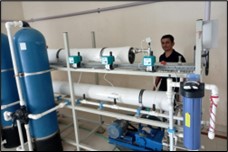INDIA H2O is about developing high-recovery, low-cost water treatment systems for saline groundwater and wastewater. The project is jointly supported by the EU Horizon 2020 programme and the Department of Biotechnology, India.
We are focussing our efforts on the arid state of Gujarat where salinity is a widespread problem. The University of Birmingham has developed a high-recovery reverse osmosis system that can convert a large fraction of saline groundwater into clean drinking water.
Working together with our partners at Pandit Deeyandal Energy University in Ghandinagar, we are developing two field trials of this technology. One of these is based in a village in the coastal region of Gujarat where it will purify the groundwater as well as providing irrigation for salt-tolerant crops.
This solution is energy efficient and driven by solar. The projects draws together expertise from Denmark, Netherlands, Spain as well as UK and India. (contact Philip Davies)
External link: Low-cost Water Treatment Systems | INDIA-H2O
SLAWP is a project funded by Network Rail Southern Region, which aims to improve railway lineside asset performance in extreme weather conditions. This goal is achieved by evaluating Network Rail's existing weather thresholds, assembling extensive datasets that encompass asset features, such as performance and failure, in relation to pertinent weather conditions, and by systematically categorising and scrutinising faults with a particular emphasis on train minute delays.
 Figure: Field trial at Lodhwa in India
Figure: Field trial at Lodhwa in India
Through this data-driven approach, the project has successfully identified network areas highly susceptible to disruptions from tree and leaf fall, as well as regions where drought conditions could potentially cause incidents and delays.
In its forthcoming second phase, SLAWP plans to leverage machine learning techniques to create predictive models, thereby facilitating more proactive and efficient maintenance of railway lineside assets. Contact Dr Soroosh Sharifi.